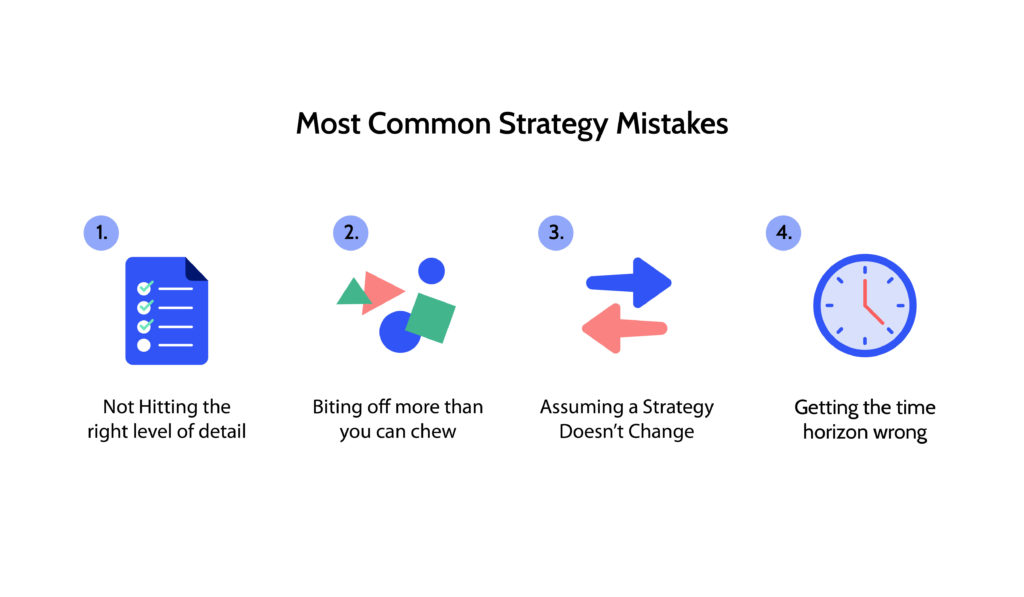Here are four common strategy mistakes that I have observed over the years. But first, a word about strategy…and trifles. Many people think of a strategy as being an all-encompassing document with broad strategic objectives, loaded with buzzwords and lacking in detail. A good strategy should be like a trifle – layers of detail building up to broad strategic objectives; the cream on top supported by the biscuit and sponge layer (initiatives) that underpin your strategy.

Strategy Mistake # 1: Not Hitting The Right Level Of Detail
Strategies exist at all different levels and for myriad purposes, and therefore audiences. You may design a corporate strategy, which will be read by all employees and shareholders. A technology refresh strategy, which targets the IT and management teams. A digital strategy, as a component of a larger strategy targeted to a specific team. The structure, scope, and detail of a strategy must be appropriate for the target audience and then be supported by further detail (which might be a sub strategy) to ensure they can be implemented.
Particularly with cross or whole-of-business strategies, the level of detail needs to be right to carry across the organisation. These strategies can then have layers underneath (which may be separate strategies) that detail how they will achieve the overarching strategy.
It’s important to have layers in your strategy – (just like in a trifle!) that support strategic objectives (the top of the trifle), and strategic initiatives (the ingredients of each layer – berries, jelly, cream) that make up each layer. A number of factors (such as the scope and duration) will guide how many layers (and ingredients!) your strategy should have.
The initiatives that you craft, need to be understood and actionable – listing out dependencies, precursors, subsequent actions or initiatives. It is important to get the level of detail right in these. Where they are too prescriptive or too detailed may not be able to be implemented. Equally, if they’re too vague or high-level, they may also not be able to be achieved, or implemented incorrectly, impacting the success of other components of the strategy.
Mistake #2: Biting Off More Than You Can Chew
Do not fall into the common trap of trying to do everything at once and do not expect your strategy to include every issue or opportunity. A strategy that is all-encompassing will overwhelm your staff and increases the risk of failure. Strategies should have identifiable, measurable goals and targets that are achievable. Goals and targets should be underpinned with activities for implementation and a timeline which is realistic conservatively considering your current resources.
Mistake #3: Assuming A Strategy Doesn’t Change
A well-designed strategy is not a “Set and Forget.” When correctly designed and implemented they should nearly be living and breathing. Consider a technology strategy from the end of 2019. I’d be willing to bet some changes were required in Q1-2/2020 when the spread of COVID-19 rapidly increased globally. Although an extreme example, all strategies should be subject to change. A good strategy will outline the goals, the rationale for needing to achieve them, and the expected results. Then, when circumstances do change, those inputs can refine the strategy and ensure it remains on track.
Mistake #4: Getting The Time Horizon Wrong
In what time frame do you want to achieve your strategy? Previously, strategies were created with 3- to 5-year horizons, particularly true of technology strategies. With the pace of change, that is no longer suitable in most circumstances. The advent of microservices, AI, and the rate of innovation means that strategies need to be set to achieve realistic goals in a realistic time period. Don’t create a laundry list of goals with a longer time horizon in the hope that they’ll be done. Because by then, the priorities of the business or the technology underpinning the strategy, will have changed and those strategic outcomes may not be relevant.
I hope you have enjoyed reading about the 4 common strategy mistakes. You might like to read:





Leave a Reply